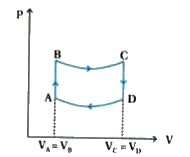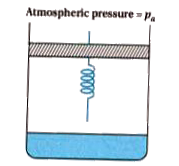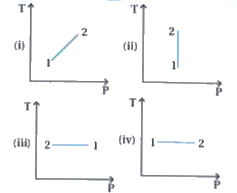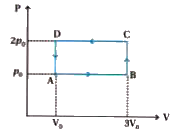Section-D Ncert Exemplar Solution (MCQs More than one option ) from KUMAR PRAKASHAN KENDRA PHYSICS (GUJRATI ENGLISH) THERMODYANMICS for Class 11
| Class 11 | PHYSICS |
| Chapter | THERMODYANMICS |
| KUMAR PRAKASHAN KENDRA PHYSICS (GUJRATI ENGLISH) | Section-D Ncert Exemplar Solution (MCQs More than one option ) |
| Medium | English |
| Academic Year | 2023-2024 |
Question 5
Consider two containers A and B containing identical gases at the same pressure, volume and temperature. The gas in container A is compressed to half of its original volume isothermally while the gas in container B is compressed to half of its original value adiabatically. The ratio of final pressure of gas in B to that of gas in A is View SolutionQuestion 6
Three copper blocks of masses M1,M2 and M3 kg respectively are brought into thermal contact till they reach equilibrium. Before contact they were at T1,T2,T3(T1>T2>T3). Assuming there is no heat loss to the surroundings, the equilibrium temperature T is (s is specific heat of copper)View SolutionQuestion 20
In a refrigerator one removes heat from a lower temperature and deposits to the surroundings at a higher temperature. In this process, mechanical work has to be done, which is provided by an electric motor. If the motor is of 1 kW power and heat is transferred from −3∘ C to 27∘ C, find the heat taken out of the refrigerator per second assuming its efficiency is 50 % of a perfect engine. View SolutionQuestion 22
The initial state of a certain gas is (Pi,Vi,Ti). It undergoes expansion till its volume becomes Vf Consider the following two cases :
(a) the expansion takes place at constant temperature.
(b) the expansion takes place at constant pressure. Plot the P-V diagram for each case. In which of the two cases, is the work done by the gas more ?View SolutionQuestion 23
Consider a P-V diagram in which the path followed by one mole of perfect gas in a cylindrical container is shown in figure.

(a) Find the work done when the gas is taken from state 1 to state 2.
(b) What is the ratio of temperature T1T2 if V2=2V1 ?
(c) Given the internal energy for one mole of gas at temperature T is 32RT, find the heat 2 supplied to the gas when it is taken from state 1 to 2, with V2=2V1View SolutionQuestion 24
A cycle followed by an engine (made of one mole of perfect gas in a cylinder with a piston) is shown in figure.

A to B: volume constant
B to C: adiabatic
C to D: volume constant
D to A: adiabatic
VC=VD=2VA=2VB
(a) In which part of the cycle heat is supplied to the engine from outside ?
(b) In which part of the cycle heat is being given to the surrounding by the engine ?
(c) What is the work done by the engine in one cycle ? Write your answer in term of PA,PB,VA
(d) What is the efficiency of the engine ? (γ=53 for the gas , CV=32R for one mole ) View SolutionQuestion 25
A cycle followed by an engine (made of one mole of an ideal gas in a cylinder with a piston) is shown in figure. Find heat exchanged by the engine, with the surroundings for each section of the cycle. CV=32R

(a) A to B : constant volume
(b) B to C: constant pressure
(c) C to D: adiabatic
(d) D to A: constant pressureView SolutionQuestion 27
Consider one mole of perfect gas in a cylinder of unit cross section with a piston attached as shown in figure. A spring (spring constant k) is attached (unstretched length L ) to the piston and to the bottom of the cylinder. Initially the spring is unstretched and the gas is in equilibrium. A certain amount of heat Q is supplied to the gas causing an increase of value from V0 to V1.

(a) What is the initial pressure of the system ?
(b) What is the final pressure of the system ?
(c) Using the first law of thermodynamics, write down a relation between Q, Pa, V, V0 and k.View Solution
All Exercises from KUMAR PRAKASHAN KENDRA PHYSICS (GUJRATI ENGLISH) Class 11 PHYSICS THERMODYANMICS
- SECTION-A (QUESTIONS-ANSWER )
- SECTION-A (TRY YOUR SELF )
- SECTION-B NUMERICALS (NUMERICAL FROM .DARPAN. BASED ON TEXTBOOK )
- SECTION-B NUMERICALS (NUMERICAL FROM TEXTUAL EXERCISE)
- SECTION-C (OBJECTIVE QUESTIONS (ASSERTION & REASON )
- SECTION-C (OBJECTIVE QUESTIONS (FILL IN THE BLANKS ) )
- SECTION-C (OBJECTIVE QUESTIONS (MATCH))
- SECTION-C (OBJECTIVE QUESTIONS (TRUE & FALSE ))
- SECTION-C (OBJECTIVE QUESTIONS (VSQS))
- SECTION-D NCERT EXEMPLAR SOLUTION (LONG ANSWER )
- SECTION-D NCERT EXEMPLAR SOLUTION (MCQS MORE THAN ONE OPTION )
- SECTION-D NCERT EXEMPLAR SOLUTION (MCQS)
- SECTION-D NCERT EXEMPLAR SOLUTION (SHORT ANSWER )
- SECTION-D NCERT EXEMPLAR SOLUTION (VERY SHORT ANSWER )
- SECTION-E MCQS
- SECTION-F QUESTIONS FROM MODULE
- QUESTION PAPER






